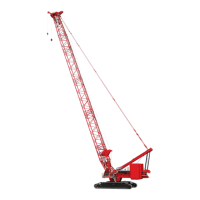HOISTS MLC165-1 SERVICE/MAINTENANCE MANUAL
5-46
Published 05-26-17, Control # 238-02
BLOCK-UP LIMIT SWITCH
A block-up limit (also called anti-two-block device) is a two-
blocking prevention device that stops the load drum from
hoisting and the boom (or luffing jib) from lowering when a
block or hook is too close to the sheave.
NOTE The block-up limit is a protective device designed
only to assist the operator in preventing a two-
blocking condition. Any other use is neither
intended nor approved.
The block-up limit system consists of the following
components (see Figure 5-32
):
• A limit switch (3), wired for normally closed operation,
fastened at the lower boom point (1) and the upper
boom point (2).
• Upper Boom Point (1 or 2-part)
• Fixed Jib Point (1-part)
Single Part
Reeving
2-Part
Reeving
Location of Components at Boom Top Shown
Location of Components at Jib Tops is Similar
Figure 5-32. Block-Up Limit Components
11
M100767a
• Lower Boom Point (multiple part)
• Lower Boom Point (two lines over point)
• Fixed Jib Point (2-part)
See Load Block Reeving Diagrams for
Suggested Location of Weight with
Multiple Part Reeving
M100767b
11
8
Item Description
1 Lower Boom Point
2 Upper Boom Point
3 Block-Up Limit Switch
4 Chain (varying lengths)
5 Weight
6Lift Plate
7 Hook-and-Weight Ball
8 Weight
9Lift Block
10 Load Block
11 Chain, Shackle, and Pin
WARNING
Two-Blocking Hazard
Two-blocking is the condition in which the load block or
the hook-and-weight ball runs into the boom or jib
sheaves.
Two-blocking can result in failure of the sheaves and
wire rope, possibly causing the load to fall.
The operator shall determine the fastest line speed that
allows the block-up limit to function properly and
thereafter not exceed that line speed.
If the block or hook-and-weight ball approaches the
boom sheaves too fast, the block-up limit may not
prevent two-blocking.
